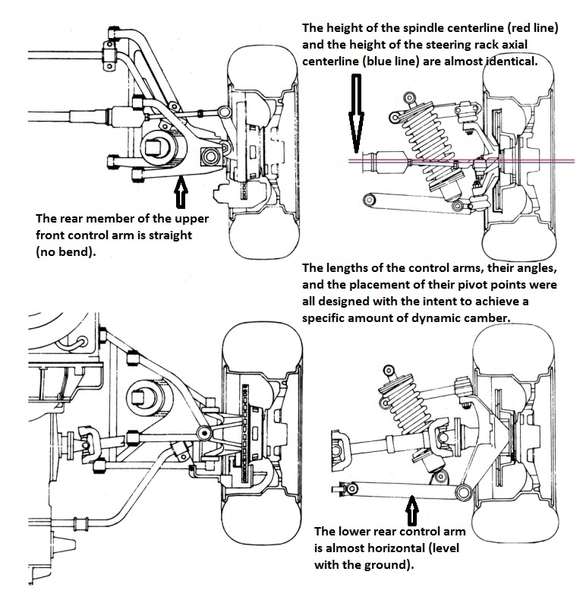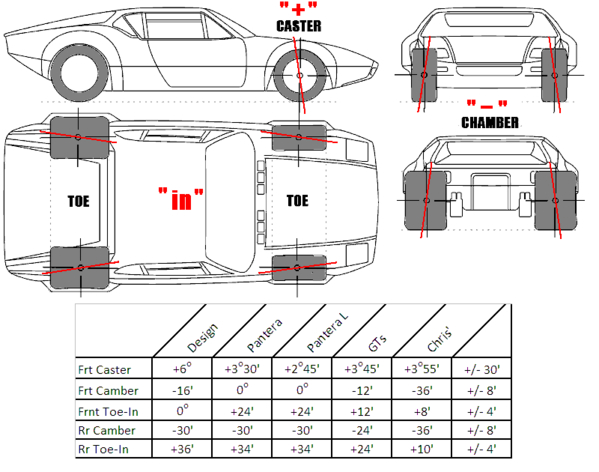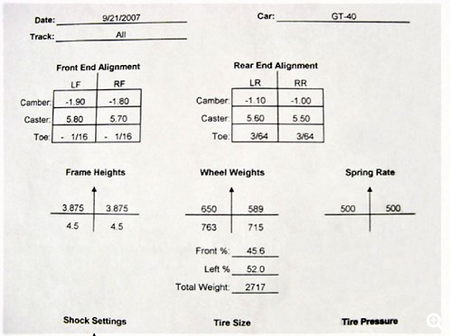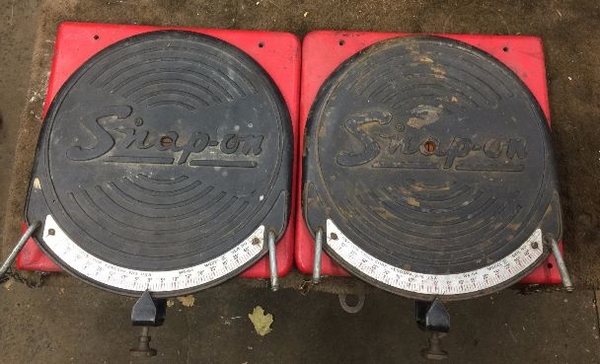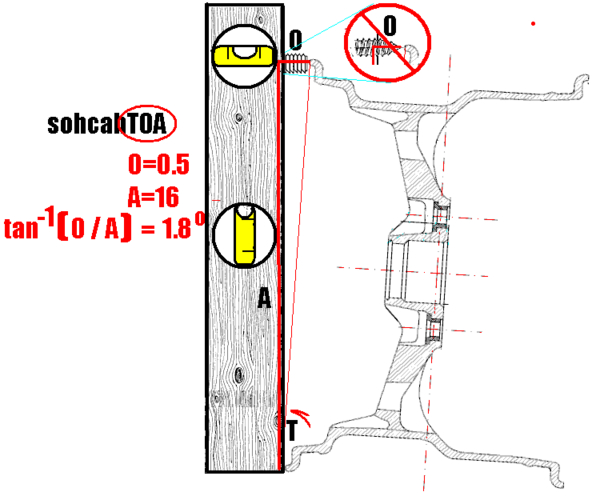I know this is an often discussed topic but for my feeble brain maybe I can get something EZ to grasp. I've rebuilt front and rear suspension: Pantera Performance Koni adjustable shock/spring packages, new ball joints/tie rod ends, new bearings/seals, rebuild calipers, rebuilt steering rack, poly bushings, new sway bar bushings, new BFG tires 205/60-15 front/245/60-15 rear. Powder painted A-arms.
I want to have a 4 wheel alignment done (probably skip the corner balancing). This is essentially a stock car with no intent of doing any track or crazy street racing. I just want a setup where the handling is good for rational driving (Hey .. I'm old). I don't want to add any special adjustment components to the suspension,just work with what I have.
So what are the recommended numbers for the shop to follow? I know you collectively have the answer. ![]()
Replies sorted oldest to newest
This works for me,the "Big Brand" tire store who did my alignment had the Pantera in the system, check the upper right of the screen, the caster is not stock, but you should get as much as you can. I do not have the rear, I believe the camber is the same and the toe in is 0.16.
Attachments
Preparation: In preparation to performing chassis adjustments the fuel tank should be half full with fuel, an equivalent amount of weight to the driver & passenger should be placed upon the seats and floorboards, and the tires should be filled to the appropriate air pressure.
Front Tire Pressure: a tire's diameter and the inflation air pressure are the two biggest factors determining its load capacity, its temperature, and the shape and size of its contact patch. If the front tires are approximately 25 inches diameter it is probably best to start at the factory setting (28 psi) and adjust up or down from there to achieve equal wear across the tire. If the front tires are approximately 24 inches diameter it is probably best to start at the later factory setting for the European GTS (31 psi).
Front Caster: The front caster spec for the Panteras assembled during the Ford era is +3° to +4° for Pre-L versions, and +2-3/4° for the Pantera L. The spec for Panteras assembled in the "Post Ford" era is +3-1/2° to +4°.
This is an ADEQUATE amount of caster for providing directional stability so long as the front toe-in is adjusted properly. Directional stability is not an issue ... but there is undeniably room for improvement. The Pantera (and other mid-engine cars) needs more positive front caster than other cars you may be familiar with due to the weight distribution of the chassis. Some owners prefer to increase positive front caster; they may be doing so to improve directional stability or their goal may be to improve dynamic camber.
Dallara intended for the Pantera to have 6° positive caster. Positive caster causes the outside front tire to lean inwards when the steering wheel is turned off-center, thus increasing the negative camber of the outside front tire in corners. The more the steering wheel is turned, the more the outside front tire leans inward. Positive caster also causes the inside front tire to lean outwards (towards the inside of the corner) when the steering wheel is turned off-center, thus decreasing the negative camber of the inside front tire in corners to such an extent that the inside front tire is cambered in the positive direction. The more the steering wheel is turned, the more the inside front tire leans outward.
The change in camber based upon steering angle is an integral part of the camber change characteristics engineered into a chassis, known as dynamic camber. Ford reduced positive caster to +3° in order to create understeer, and slow the car's response to driver input. The change in dynamic camber is why reducing caster achieved Ford's goal, and why reducing caster impacted more than just directional stability. Ford reduced caster by bending the upper front control arms so as to move the upper front ball joints about 1/2 inch forward. This is the second way in which Ford upset the dynamic camber engineering of the Pantera's chassis. There was a cosmetic downside to Ford's alteration as well, the front tires were no longer centered in the fender openings, they were shoved forward.
The earliest Panteras had no adjustability for front caster, later a small amount of adjustability was added. If caster is adjustable then stack all the adjustment shims in front of the upper ball joints and set it for as much positive caster as you can squeeze out of its adjustments, +4° may be attainable in some chassis. Every 3/16 inch (4.7mm) the upper ball joints are moved rearward should increase positive caster by 1°. Caster up to +6° is desirable, but it is not realistically attainable unless the upper front control arms are modified. Front caster should be the same side to side.
Front Camber: Adding negative front camber is the major way in which modern Pantera alignment varies from Ford's specification.
The static camber applied to the suspension was originally specified taking into account the "dynamic camber" engineered into the chassis. Dallara originally specified -1/4° front camber (-0.250°), and therefore this is my recomendation. Negative camber means the tops of the tires are tilted inward towards the middle of the car. Adding negative front camber restores some of the excellent cornering grip the Pantera's chassis is capable of having, and allows the chassis to respond more quickly to driver input.
Additional negative front camber can be added, but the car may not benefit from extra negative camber "if" the chassis is set at the European ride height and "if" front caster has been set around +5° or +6°. However additional negative camber is a universal "band aid" for cars in which the dynamic camber is unknown or "out-of-whack". Keep in mind the front camber setting must also take the rear camber setting into consideration, the two settings MUST complement each other, in as much as the balance between the two impacts the chassis' balance in corners. It is reasonable to limit the amount of negative front camber to not exceed the amount of negative rear camber (i.e. -1/2° or -0.500°). As with other chassis settings the amount of negative front camber should be the same side to side.
Front Toe: The Pantera needs a certain amount of toe-in to achieve directional stability, for most chassis only a small amount of toe-in is required. The indications of insufficient toe-in and too much toe-in are the same, the slightest movement causes the car to wander or dart left or right, the steering can be described as nervous or twitchy, the driver has to "focus on direction" an unusual amount to keep the car going straight.
When toe is measured the old fashioned way as the difference of the distances between the tire centerlines at the front of the tires and the back of the tires, it is specified in inches. Measured this way toe will vary "slightly" with the diameter of the tires. Tire diameter does not impact toe when it is measured in degrees with modern equipment. Toe measured in degrees should be the same for both the front and rear tires. Toe measured in inches is slightly less for the front tires because the front tires are smaller in diameter than the rear tires.
The Pantera does not settle to ride height after being jacked up to adjust camber. When toe-in is set to spec after the car has been jacked up, it becomes toe out as soon as the car is driven a short distance and the front suspension settles.
0.14° toe-in is a good place to start. Measured in inches that would be 0.122 inch (just under 1/8 inch) for front tires that are approximately 25 inches diameter , and it would be 0.117 inch for front tires that are approximately 24 inches diameter. Bounce the front of the car after making this adjustment, due to the stiction in the suspension. Adjust it until the 0.14° toe-in setting is maintained before and after bouncing. If the car feels "twitchy" afterwards the toe-in adjustment will need to be changed. Changes should be made in small increments because too much toe-in is just as bad as insufficient toe-in.
Rear Tire Pressure: If the rear tires are approximately 27 inches diameter it is probably best to start at the European factory setting (31 psi) and adjust up or down from there to achieve equal wear across the tire. If the rear tires are approximately 26 inches diameter it is probably best to start at the later factory setting for the European GTS (34 psi).
Rear Caster: is not adjustable.
Rear Camber: Trailing throttle over-steer is a potential problem with mid-engine cars. Rear camber contributes to preventing over-steer. A setting of -1/2° (or -0.500°) is consistently recommended in the various Pantera alignment specifications, for versions which have rear tires varying in width from 215mm, 255mm, 285mm, and 345mm! However -1/2° (or -0.500°) was the maximum setting for Panteras equipped with the widest tires (Pirelli P7s). I assume this amount of rear camber was specified taking three criteria into account: the needs of the chassis based upon dynamic camber, the trailing throttle forces which cause over-steer, and tire wear. The rear camber should also be the same side to side.
If you're having trouble eliminating excessive negative rear camber, this is due to the inner wheel houses folding or flexing inward where the upper control arms mount. This is a common problem with the Pantera. The solution is to install adjustable upper rear control arms which are commercially available. Some owners will attempt to "spread" the inner wheel houses apart with an adjustable chassis brace, which is commonly referred to as a spreader bar. However, the design and attachment of the original rear chassis brace and the spreader bar which replaces it is inadequate for stabilizing the wheel houses structure. If it were adequate, the wheelhouses wouldn't fold-inward as they do.
Excessive negative camber will cause accelerated rear tire wear. There is a tendency to over-compensate for the excessive camber caused by wheel house flexing by setting the rear camber at zero in the hope that the camber adjustment will "settle' into an acceptable (BUT UNKNOWN) amount of camber as the car is being driven. However, it would be better to resolve the problem than to compensate for it by setting the rear camber at zero. The best solution shall be to take steps to eliminate wheel house flex ... such as more substantial bracing, welding seams, adding gussets, etc. Stiffening the wheel houses will have the added benefit of eliminating the nasty habit of the rear tires to loose traction suddenly instead of progressively.
Other aspects which impact rear tire wear include tire width, spring rate, and chassis height. The more the suspension compresses when the driver and passenger sit in the car, the more the car leans in corners, or the wider the rear tires are, the worse rear tire wear shall be. The solutions to these possible issues are obvious, limit the width of the rear tires (275mm to 295mm), set the chassis at its European ride height, and/or increase the spring rates. If achieving the chassis' best handling performance is your goal, it is better to have a 285mm rear tire and a small amount of negative camber, than to have 335mm rear tires and no rear camber.
Rear Toe: As with the front tires 0.14° toe-in is a good place to start. Measured in inches that would be 0.132 inch for rear tires that are approximately 27 inches diameter, and it would be 0.127 inch (just over 1/8 inch) for rear tires that are approximately 26 inches diameter (bounce the suspension as you did for the front). Toe measured in degrees should be the same for both the front and rear tires. Toe measured in inches is slightly greater for the rear tires because the rear tires are greater in diameter than the front tires.
Attachments
These are all good numbers BUT they are going to be slightly different for different tires and/or wheels.
With the amount of usage these cars are getting,i.e., low mileage totals, I think the vast majority are "safe" with a little more of an aggressive setting.
-1/2 to -3/4 castor, around 3/16" toe in.
IF you opt to go for more castor, there will be much more steering effort. THEN a power steering unit would be a good consideration.
In the past, toe-in was always an approximation. It's designed to given the car predictability.
On an independent rear suspension car it is IMPERATIVE to have more than 1/8" toe in.
The nature of this car is to over-steer if you just fart and unless you drive it exclusively without switching cars, you won't be able to adjust to the change instantaneously.
Ford's changes were in consideration of an average driver off the streets to be able to just jump in and drive it safely.
As soon as you start changing parts, everything in a Pantera will effect it. Put on ALL of your new parts first, then align it, OR re-align it after every change.
Incidentally, you need to decide on your tire air pressure also. That does change the handling often dramatically. If you don't believe me, ask the guys that race.
Just going from 32psi to 40psi on an autocross track made it a different car.
I don't know what you need to put in the tires to go 200mph? Then you need to specify the track surface and the surface conditions.
Robbie I am old too, but the idea is to make your car easy to drive and have good handling characteristics, tire wear concerns seem silly to me, that said independent rear suspension with added toe in = stability in the corners and is helpful in recovering from rear traction loss, toe in in the front helps with stability / cornering. Adding caster as George mentioned creates a significant improvement in straight line stability.
Attachments
The chart I copied from "somewhere", I am not getting equivalent values when I try to go back and forth from angle to inches
quote:Originally posted by JFB #05177:
question...Isn't toe measure at the OD of the tire?
The chart I copied from "somewhere", I am not getting equivalent values when I try to go back and forth from angle to inches
Yes. Toe in is the difference of the "track" between front and back of the tire.
It isn't measured in degrees to my knowledge. I've only seen it stated in inches.
That chart could be for a specific machine but frankly you can do toe in with a tape measure on the floor.
It is an approximation. It will change on the same car by just changing from a bias tire to a radial since the wall of the radial tire is softer and the only way that you can standardize the measurements is off of the wall of the tire, not the tread.
Trying to read it from the tread is inaccurate.
I do it by clamping plywood plates to the tire with a bungee cord. The plates sit on the floor and measure the distance between them along the floor.
Computerized alignment machines are WAY over rated. They are most useful for adjusting the camber since the front plates are easily moved in and out with the car weight sitting fully on them.
You set the camber off of the rim of the wheel though.
Every club racer that I know of does their own alignment on the garage floor unless they own their own shop with an alignment machine.
Every car is going to be different. Those charts are just a guide. They don't need to be set to a 1/10th of a degree.
My Pantera is set at 5/8 of a degree negative BUT that's because that's where the tread of the tire sits flat and equally loaded.
My 92 SHO Taurus was set at -2 degrees to get the tire flat on it's treads. Factory specs were for the stock tire. When I went from a 215-60-16 to a 245-55-16 the change became mandatory. Stock settings would no longer work.
The type of tread pattern that the tire has CAN also effect the exact toe in setting. 3/16 might feather edge the blocks in the tread while 1/8 might not. A race tire with a "slick" pattern no longer cares about that consideration.
You may in fact need to "play" with the settings until the car is right?
You also need to standardize the air pressure in the tires. Too low of a setting and things like the toe-in will change too much in hard cornering.
More is better then less. Just for the sake of discussion if say you usually run 32psi, go to 40 psi and go drive the car. You will more then notice the change in handling.
I measure on a beam in front and in the rear. Simple triangulation math gives you the toe in in degrees or inches at the tire. Google triangular calculators.
For camber measurements, I use a vertical carpenter laser. Measure the distance at the bottom of the rim to the top of the rim with a ruler.



You can do it the string method, I do for my race car setup, but I have purposes built string bars for each car front and back and ensure strings are parallel. Tire walls are not all equal so it's better to do it from the wheel rim edge and knowing the distance between the two you can easily calculate the angle.
Degrees are far easier and more accurate as they are not affected by tire size as you are simply measuring the plane of the wheels to parallel.
Julian
quote:Originally posted by UFO-LOW:
A question: I seem to remember a formula for determining caster from the camber. Something like measuring camber with the front wheels turned 20 degrees left & right, then a calculation to get the caster. Anyone have the info on this?
I can't recall the true math at the moment,
the simple math was to measure camber at exactly plus and minus 20 degrees of steering.
then sum the two values from;
chamber at +20 degrees minus 90
chamber at -20 degrees minus 90
then multiply that sum by 1.5 will give caster.
However it doesnt let you know is it is positive or negative caster. AND the 20 degrees steer determines that the 1.5 constant, differnt turn angle needs differnt multiplier
the multipier for different total steer angles would be 57.3/total steer angle. this actually has the multiplier as 1.43 for the 40 degrees total steer (close enough)
quote:Originally posted by Joules:
My alignment gauges are in degrees, as are virtually all I have encountered.
You can do it the string method, I do for my race car setup, but I have purposes built string bars for each car front and back and ensure strings are parallel. Tire walls are not all equal so it's better to do it from the wheel rim edge and knowing the distance between the two you can easily calculate the angle.
Degrees are far easier and more accurate as they are not affected by tire size as you are simply measuring the plane of the wheels to parallel.
Julian
Yes but with a radial tire, the wheels literally could be at spec and the tires could be toed out because of the soft wall nature of the tire wall.
Bias tires would be more accurate but consider that it is the tire tread that needs to be toed in.
The tire also needs to be warmed up, not stone cold AND the tire air pressure needs to be at spec. Some put 50 psi in them just for alignment purposes.
This is why the toe in is an approximation. I find that it is better to have it set at 3/16 to 1/4" total rather then at 1/8".
Oh, you also should ballast the car.
Where were those tables when I needed them George? Those and the little portable truck scale? Hum? Nice.
Castor is a real PITA to do. Anything will help.
The only problem with the level, Comp2, is the floor needs to be level at all points. I've got the laser level too but it is a pain to use.
Mark the floor where the tires go, then get those points all level to themselves, then put the laser away. Mine probably needs batteries. I haven't used it in years?
Just convert the degrees into inches or mm. Put a bolt through the level (thread the level) and adjust the bolt to what you want for camber and lock it in place. Then you can just use it for a "quick check" by holding it up to the wheel.
SOH, CAH, TOA, on the geometry, or is that trig? I think that works out to 1/2" on the camber on a 16" level?
With 6 degrees of castor, don't you get wheel to fender contact in the front of the arch and need to limit the tread and cross section of the tire to eliminate that on a slab side car?
quote:Originally posted by PanteraDoug:
Just convert the degrees into inches or mm. Put a bolt through the level (thread the level) and adjust the bolt to what you want for camber and lock it in place. Then you can just use it for a "quick check" by holding it up to the wheel.
SOH, CAH, TOA, on the geometry, or is that trig? I think that works out to 1/2" on the camber on a 16" level?
considering below recomendations, edited the illustration to remove the "mansonary screw" and replace with bolt threads
Attachments
My tape measure is in inches with a secondary metric marking.
I know of none, including mine, that is marked in degrees or what tan .03125 means in degrees?
Make this easier, not harder.
Sounds like the kind of place that you need?
Don't be surprised if they say something like "try this" setting, with their numbers (not mine or "ours")?
I don't think anything is written in stone? Driver input is important. If the car doesn't feel right then something needs to be done.
All of those "chart settings" are for a box stock "production car". As soon as you change anything, they mean less and less.
PROBABLY "auto cross" guys can help you the most since those settings are the closest to what you will be driving on the street.
It makes little sense to set the car up for 200mph. That's just some kind of an ego trip. The big caster numbers are the biggest part of that. 6 degrees is for 200mph, not for autocrossing around a parking lot. Stock 73-74 castor is plenty for that AND high speed events that you do "once in a while" or even once in a lifetime.
Stock, a Pantera was set up NEW for virtually anyone in the US, to jump into the car and go fast. With that set up, you run into a wall though. That wall is around 150mph. Over that, different factors come into play.
150 is about what a novice in a Pantera can handle ON THE STRAIGHT in a Pantera. Over that you need LOTS of experience. The required experience is also specific to that car in my opinion.
Best of luck with your endeavor. ![]()
quote:Originally posted by Robbie:
Opps .. a ps .. 72 pre-L, SN 3518.
Robbie we could be related mine is 3840 a July
72 Euro GTS,
sorry to crash the post lads.
For those of you who are using a shaved upper ball joint to get more caster, do you know the amount to mill from the edges of the ball joint? How much additional caster can you get from that?
My car is an early '73. Are the '71 upper A-arms or ball joints different and enable larger caster settings from stock components or are they just located in a slightly different location?
Many owners successfully use 0.090" or 0.100" shaved from one side. This is a safe amount that does not fall into the grease cavity for the ball joint. Good for about 1 more degree of caster additive to whatever else you use.
The front suspension for very early Panteras/pushbuttons is considerably different than what was used in the first revision for production. Looking at the Illustrated Pantera Parts Manual will show the myriad differences in upper a-arms, steering arm, upright forging and removable spindle. Alignment specs were also different since neither coil spring spacers nor bump-steer spaces were used. This is pure Dallara. Later was Ford engineering.
@bosswrench posted:Many owners successfully use 0.090" or 0.100" shaved from one side. This is a safe amount that does not fall into the grease cavity for the ball joint. Good for about 1 more degree of caster additive to whatever else you use.
Larry Stock offers the ball joints pre-shaved. It takes a 5/32" shim. I don't know what that translates to in the amount he cuts off?
I can't get a straight answer from him other then he gets about 4.5° total using the shaved ball joint and offset bushings which he carries also. By deductive reasoning the offset bushings must be around an additional 1.5°?
In a '60s Mustang that would be a large change, adding 2.5°, with a noticeable increase in effort with manual steering. Been there, done that.
He says there is no noticeable change in effort to him going from the stock 2° to 4.5°.
I would presume 4.5° would be a significant change in directional stability in the Pantera as well?


